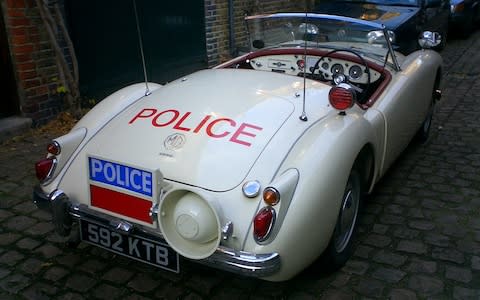On patrol with a classic MG police car

One of the cars most often associated with the Goodwood Revival historic racing extravaganza is Simon Dwyer’s MGA 1600 Mk1, which serves as the Course Car and is ready for any eventuality.
That is entirely fitting, as 592 KTB started out as one of a batch of 12 ordered by Lancashire Constabulary in 1959, and 60 years ago you might have encountered it on duty on the Preston By-pass, Britain’s first motorway-standard road.
In the late 1950s Lancashire was the country’s largest force outside of London, and it was renowned for its innovations in highway policing, from pioneering the use of radar to its choices of car. The force commissioned its first MGs in 1932, with the A roadster joining the fleets in late 1955.
According to Andrea Green’s engrossing book M.G.s on Patrol, Area Cars sported a black livery while the Traffic Cars were painted white. This was highly unusual for a British police vehicle at the time, but the Chief Constable, Colonel Sir Eric St Johnston, thought that this helped the MGs to “stand out”.
A further major talking point was that WPCs crewed the MGAs, which caused many tweed-jacketed Humber Hawk owner to drop their pipes in amazement. One 1957 newspaper report excitedly raved: “It is no reflection on their character to say that these women of Lancashire County Force are ‘fast’. They are equipped with MG sports cars, capable of 100 miles an hour, as the first women drivers in the traffic patrol branch.”

The police specification for 592 KTB includes two six-volt batteries, a blue flashing lamp, illuminated signs – “the one at the back can flash a ‘stop’ warning”, says owner Dwyer – and a red warning beacon on the rear offside wing.
The facia is dominated by a recalibrated speedometer and the bumpers sport replica tannoys. Dwyer believes his MGA “would have been originally fitted with two-tone klaxon horns, but my A also has a bell”.
Traffic Cars were the province of officers who had passed their ‘Standard A’ advanced driving course and they wore a distinctive white uniform cap.
One British Motor Corporation (BMC) optional extra that was not deemed necessary by Lancashire Constabulary was a heater. A blanket was issued to the officers, but it often proved to be of marginal use as the driver and wireless operator would have to roll it up to be able to see over an iced-up windscreen.

Patrols were carried out with the hood lowered, the better to enhance the MG’s profile; to have been on duty during the severe winter of 1963 must have been challenging.
A Pye transmitter occupied most of the boot space, while a Traffic Car would be additionally required to accommodate white coats, flares, ‘Accident’ signs, hurricane lamps, a fire extinguisher plus first aid and ‘incident’ boxes. This left no room for a spare tyre, and a blow-out meant radioing for a Ford Zephyr to bring another wheel.
By the early 1960s, Lancashire was starting to employ MGBs and the force decommissioned 592 KTB in 1965. About 30 years later MG enthusiasts David Cox and Andy Ginter went to look at a Mineral Blue MGA that was for sale in Northaw and Ginter recalls “we were told it was ex-police and were shown the Heritage Certificate”.

Cox bought the A, and much of the restoration was carried out by Brian Brown, who was then of the marque specialist Brown & Cook. Cox said: “The MG was quite sound although the body was like Joseph’s coat – it was in many colours!”
The car needed metal wings to replace the glass-fibre items that had been fitted at some point post-service, and the police fittings were largely sourced via the help of a serving officer who managed to find many original items that were still in storage.
By 1998 the A was once again ready for duty, and it was invited to take part in the first Revival. Ginter has vivid memories of “driving it along the M25 at 5am” and, once he arrived at Goodwood, of how “it was as though I had entered a time portal”.

Dwyer acquired the MG in 2005, and on the road he finds it “diminutive by modern standards, particularly when you are on the motorway, with juggernauts thundering past. I think any male police officer would have had difficulty fitting into the cabin, especially if he was wearing a greatcoat”.
Dwyer is still researching the MG’s history, including the call-sign, and his plans include equipping the A with a functioning loudhailer. He regards it as “one of the most fun cars I have ever owned. It is akin to a go-cart”.
592 KTB inevitably causes a stir at any event it attends, from Goodwood to London’s New Year's Day Parade and on one memorable occasion, “I was approached by a gentleman who recognised the car. He was still irate that ‘I was once pulled over by one of those and was very annoyed it was a woman officer’!”
It is a scenario that truly belongs in a Boulting Brothers’ comedy film, preferably starring Terry-Thomas as a caddish XK150 driver and June Whitfield as a police sergeant…
With thanks to Simon Dwyer (who owns originalvintagemovieposters.co.uk), Brian Brown (of Brian Brown Classics in Langley) and Andy Ginter.
For tips and advice, visit our Advice section, or sign up to our newsletter here
To talk all things motoring with the Telegraph Cars team join the Telegraph Motoring Club Facebook group here

 Yahoo News
Yahoo News 
